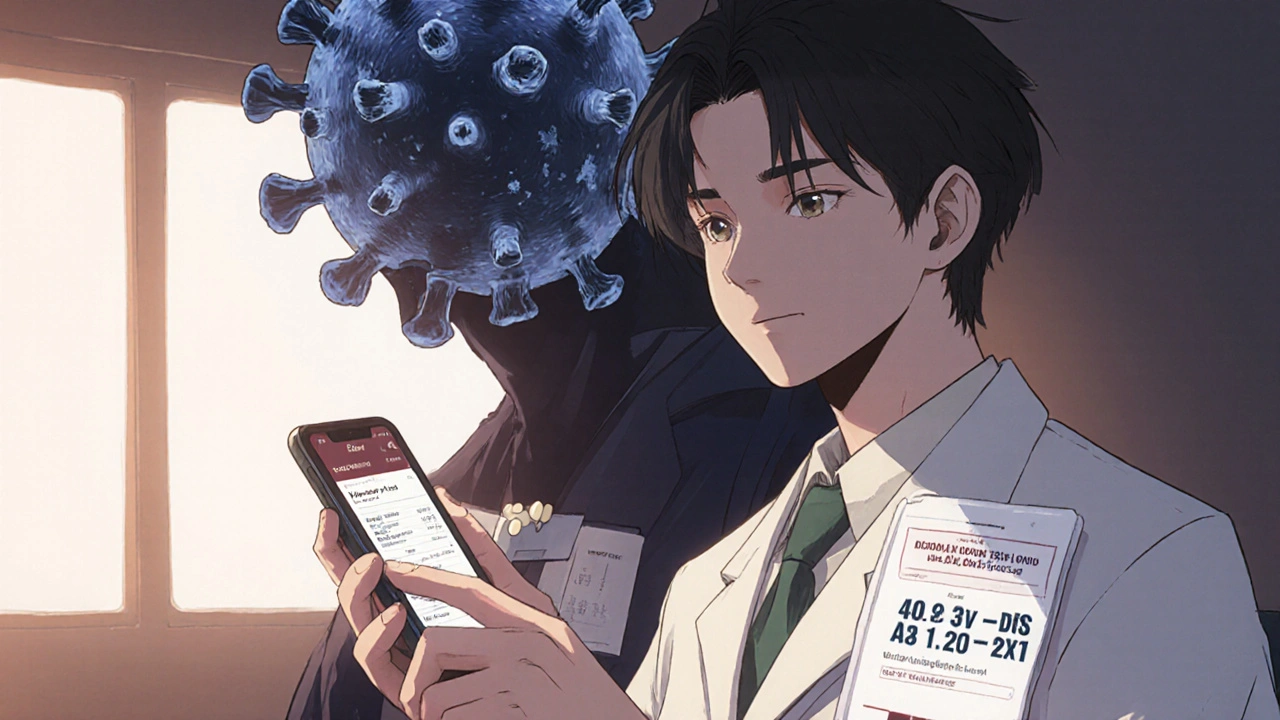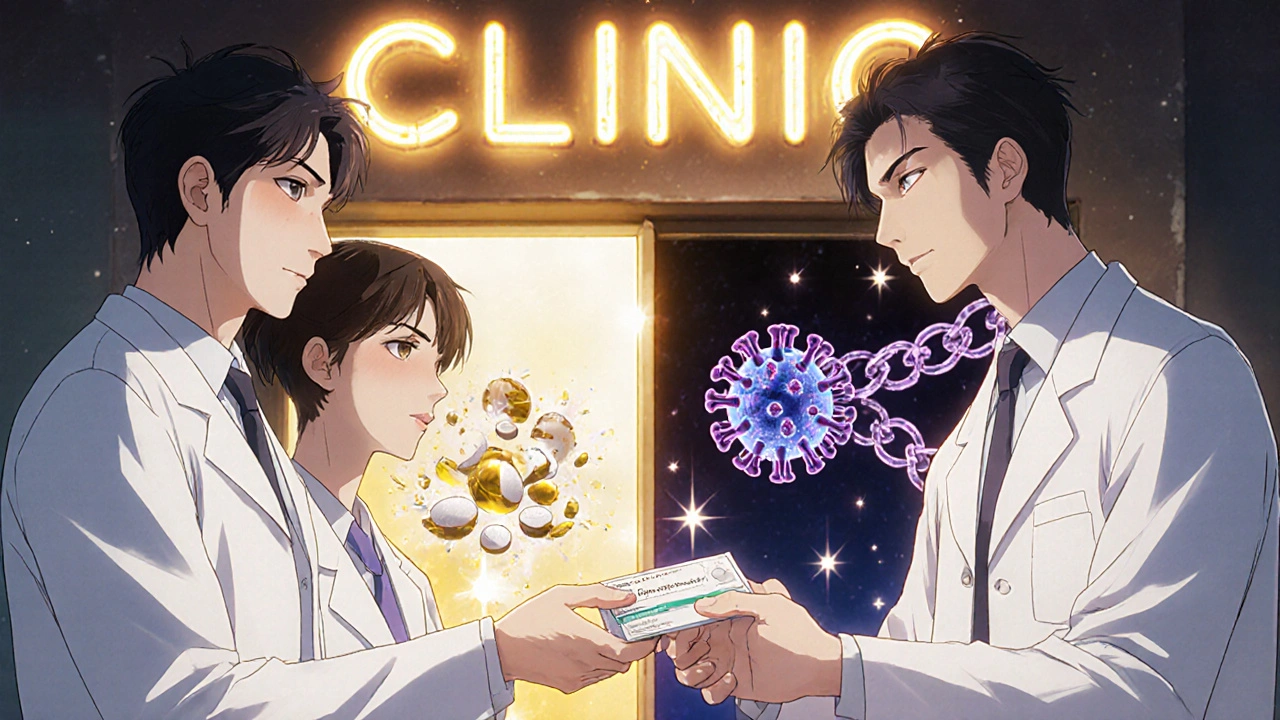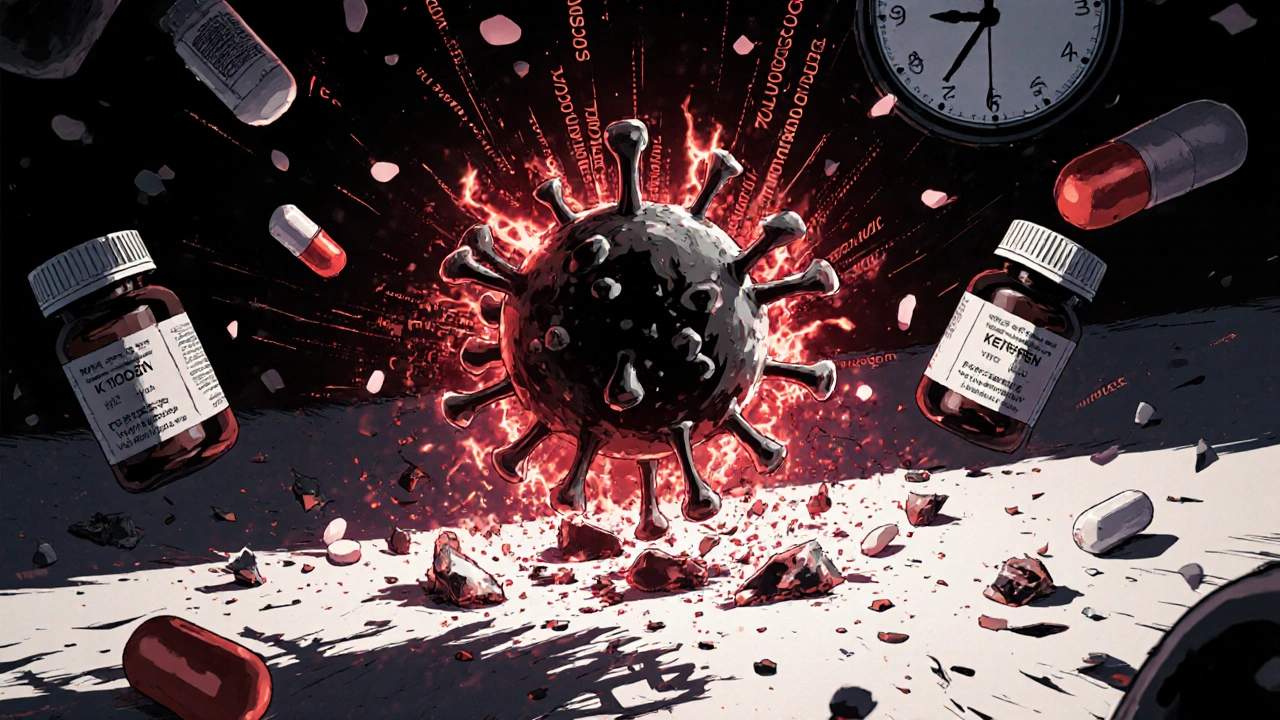If you're taking nevirapine for HIV and your viral load won't drop, or it’s starting to rise again, you’re not alone. Nevirapine resistance is one of the most common reasons HIV treatment stops working - especially in people who started treatment early or didn’t take their pills exactly as prescribed. This isn’t about being careless. It’s about how the virus evolves, how the drug works, and what happens when the balance tips. The good news? We know exactly why it happens, how to spot it early, and how to fix it.
How Nevirapine Works - and Why It Fails
Nevirapine is a non-nucleoside reverse transcriptase inhibitor, or NNRTI. It blocks HIV from copying its genetic material by latching onto a key enzyme called reverse transcriptase. Once it binds, the enzyme can’t function, and the virus can’t multiply. Simple, right? But HIV doesn’t play by human rules. It mutates fast - about 10,000 times more than human cells. Every time the virus copies itself, there’s a chance of a mistake. Most mistakes kill the virus. But some? They let it survive even when nevirapine is around.
The most common mutation that causes nevirapine resistance is K103N. This single change in the virus’s genetic code makes nevirapine slide right off its target. It’s like changing the lock so the key no longer fits. Other mutations like Y181C and G190A do the same thing. Once one of these mutations shows up, nevirapine loses most of its power. And because nevirapine has a long half-life - it sticks around in your body longer than most HIV drugs - it can linger at low levels even after you miss a dose. That’s the perfect setup for resistance: low drug pressure + high mutation rate = resistant virus wins.
Who’s Most at Risk for Nevirapine Resistance?
It’s not random. Certain patterns show up again and again in clinical data. People who start nevirapine with a high viral load (over 100,000 copies/mL) are at much higher risk. Why? More virus = more chances for a resistant mutation to appear before the drug fully suppresses it. That’s why guidelines now recommend avoiding nevirapine as a first-line drug for women with CD4 counts above 250 or men above 400 - their immune systems are still strong enough to let the virus replicate more freely at the start.
Another big risk factor? Inconsistent dosing. Missing even one or two doses a week can drop drug levels enough to let resistant strains grow. Nevirapine’s long half-life makes this worse. You might think, “I took it yesterday, so I’m covered.” But if you skip today, the drug concentration drops slowly - just enough to give resistant viruses a fighting chance. This is why adherence matters more with nevirapine than with many other HIV drugs.
And then there’s the issue of single-dose nevirapine for preventing mother-to-child transmission. In the early 2000s, it was widely used because it was cheap and easy. But studies showed that up to 40% of women who received just one dose developed nevirapine-resistant HIV. That’s not just a problem for them - it’s a problem for future treatments. If you’ve ever taken a single dose of nevirapine during pregnancy, your options for future HIV treatment are already limited.
Signs You Might Be Developing Resistance
Resistance doesn’t come with a rash or fever. It sneaks in silently. The only reliable way to know? Regular viral load tests. If your viral load was undetectable (below 50 copies/mL) and now it’s 200, then 500, then 1,000 - that’s a red flag. Don’t wait for symptoms. HIV doesn’t make you feel sick until it’s already damaging your immune system.
Some people notice a return of old symptoms - night sweats, swollen glands, unexplained fatigue. But these are late signs. By then, resistance is likely well-established. Viral load testing is your early warning system. Most clinics test every 3-6 months after treatment starts. If you’re on nevirapine and haven’t had a test in over six months, get one now.
Genotypic resistance testing is the next step. It looks at the virus’s genetic code and tells you exactly which mutations are present. If K103N or Y181C shows up, nevirapine is no longer effective. This test isn’t always done automatically - you have to ask for it if your viral load is rising. Don’t assume your doctor will know without you speaking up.

What to Do When Nevirapine Stops Working
If resistance is confirmed, you don’t need to panic. You just need to switch. The key is to replace nevirapine with a drug that still works - and to build a new regimen that’s strong enough to suppress the virus completely. The most common replacement is dolutegravir, an integrase inhibitor. It’s powerful, has a high barrier to resistance, and is taken once daily. Studies show that switching from nevirapine to dolutegravir-based regimens leads to viral suppression in over 90% of cases within 24 weeks.
Other options include raltegravir, bictegravir, or boosted darunavir. The choice depends on your resistance profile, other health conditions, and what drugs are available where you live. In many low- and middle-income countries, efavirenz was used as a substitute for nevirapine - but it shares similar resistance patterns. So if you’re resistant to nevirapine, efavirenz might not help either.
Here’s the rule: never add a single new drug to a failing regimen. That’s like putting a bandage on a broken bone. You’ll only make things worse by selecting for even more resistant strains. Always switch to a fully suppressive combination - usually two or three new drugs that the virus hasn’t seen before.
How to Prevent Resistance in the First Place
Prevention is always better than fixing broken treatment. If you’re starting HIV therapy now, nevirapine isn’t the first choice anymore. Guidelines from the WHO and the U.S. Department of Health and Human Services recommend dolutegravir or bictegravir as preferred first-line drugs. They’re more forgiving of missed doses and harder for the virus to resist.
If you’re already on nevirapine and doing well - undetectable viral load, no side effects - don’t switch unless your doctor recommends it. But if you’re struggling with adherence, or you’ve had a recent viral load spike, talk to your provider about upgrading your regimen. Many clinics now offer free resistance testing and drug switches as part of routine care.
Adherence tools help. Pill boxes, phone alarms, and apps like Medisafe or MyTherapy can cut missed doses by half. Some clinics even offer peer support or text-message reminders. Ask if your clinic has them. Also, if side effects like rash or liver problems are making you skip pills, tell your doctor. There are ways to manage those without giving up treatment.

What Happens If You Don’t Fix It?
Left unchecked, nevirapine resistance doesn’t just affect one drug. It can knock out the whole NNRTI class - meaning efavirenz, rilpivirine, etravirine all become less effective. That reduces your future options. It also increases the risk of transmitting drug-resistant HIV to others. In some areas, over 15% of new HIV infections involve strains already resistant to NNRTIs.
Long-term, uncontrolled HIV leads to lower CD4 counts, higher risk of opportunistic infections, and faster progression to AIDS. It’s not inevitable - but it’s a real risk if resistance is ignored. The good news? Modern HIV treatment is still highly effective, even after resistance. You just need to act before the virus gets too far ahead.
Final Thoughts
Nevirapine resistance isn’t a failure. It’s a sign that the virus is doing what it’s always done - adapting. The system is designed to catch it. Regular testing, open communication with your care team, and timely switches make all the difference. You don’t need to be perfect. You just need to be consistent. And if resistance does show up, the tools to fix it are better than ever.
Can you reverse nevirapine resistance?
No, you can’t reverse the genetic mutation that caused resistance. Once HIV develops K103N or another nevirapine-resistance mutation, it stays in your virus population forever. But you don’t need to reverse it - you need to outmaneuver it. By switching to a new drug regimen that the virus hasn’t seen before, you can suppress it completely again. The resistant strain may still be there, but it won’t be active or able to multiply if the new drugs are working.
Is nevirapine still used for HIV treatment today?
It’s rarely used as a first-line drug anymore. In high-income countries, it’s been replaced by safer, more effective options like dolutegravir and bictegravir. In some low-resource settings, it’s still used because it’s cheap and available. But even there, guidelines are shifting. The WHO no longer recommends nevirapine for pregnant women or people with high CD4 counts. Its use is now limited to specific cases where other drugs aren’t accessible.
How long does it take for nevirapine resistance to develop?
It can happen in weeks - especially if you’re not taking the drug consistently or if your viral load was high when you started. In studies, resistance mutations appeared in as little as 4-8 weeks in people with poor adherence. For those who took nevirapine as a single dose during childbirth, resistance showed up in 30-40% within 6 months. The faster the virus replicates and the less drug is present, the quicker resistance builds.
Can nevirapine resistance affect my partner?
Yes, if you have a detectable viral load due to resistance, you can transmit HIV that’s already resistant to nevirapine and other NNRTIs. That’s why keeping your viral load undetectable is so important - it prevents transmission entirely. If you’re resistant and not fully suppressed, using condoms or ensuring your partner is on PrEP reduces the risk. Always discuss your resistance status with your partner and care team.
What if I can’t afford to switch drugs?
Many countries offer free or low-cost access to newer HIV drugs through public health programs or global initiatives like PEPFAR and the Global Fund. If you’re struggling to afford a switch, talk to your clinic or a patient advocate. Nonprofits and pharmaceutical assistance programs often help cover the cost of dolutegravir or other preferred drugs. Don’t delay - staying on a failing regimen is riskier and more expensive in the long run.


Julie Lamb
October 28, 2025 AT 20:41This post literally saved my life. I was about to give up on treatment until I read about the dolutegravir switch. I’ve been undetectable for 8 months now 🙏
april kakoske
October 30, 2025 AT 19:01resistance isnt failure its just evolution 😌
Pradeep Meena
October 31, 2025 AT 17:42in india we still use nevirapine because rich countries have money to buy fancy drugs. you think your way is better but we survive with what we got. stop judging
Rishabh Jaiswal
November 2, 2025 AT 08:48u dont understand the science here. k103n mutation is not the only one. y181c is way more common in asia and u missed that. also nevirapine half life is 25-30 hrs not longer. google it
Dale Yu
November 2, 2025 AT 14:12so basically if you're poor or can't afford perfect adherence you deserve to have resistant HIV? that's the real message here. great. just great
Kshitij Nim
November 3, 2025 AT 06:32if you're on nevirapine and your vl is creeping up dont wait. go get that resistance test today. your doc might forget but you gotta push. i've seen too many people lose time because they were too scared to ask
Scott Horvath
November 3, 2025 AT 10:22just got my test results back. K103N. felt like the world ended. then i read this. switched to dolutegravir last week. vl down to undetectable. thank you for writing this. i feel like i can breathe again 🌱
jennifer sizemore
November 3, 2025 AT 19:07to pradeep and rishabh - i hear you. the system is broken and no one should have to choose between meds and rent. but this info? it’s still vital. maybe we can use it to push for better access? i’m in if anyone wants to start a group
matt tricarico
November 3, 2025 AT 20:47the author clearly has no understanding of global health equity. this post reads like a pharmaceutical marketing brochure dressed up as medical advice. nevirapine isn't obsolete - it's been deliberately sidelined by profit-driven guidelines. the real crisis is access, not adherence.